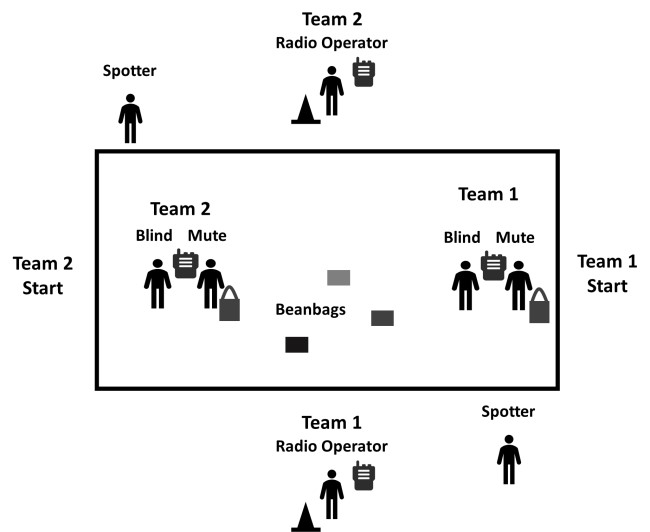Edit
Delete

Pick Up The Poo - Communication Activity
The Adventure
See different methods of communication in action as you work as a team to 'pick up the poo'!
Plan
- Investigate different ways in which humans communicate with each other. Consider how the senses of touch, sight, and sound all factor into how we communicate with other people.
- Gather the required equipment:
a. Small beanbags of various colours - the 'poo' in this game
b. Bags (such as freezer bags) to act as 'dog poo collection bags'
c. Buckets to collect beanbags in
d. Two handheld radios per team
e. Two cones to mark the Communications Point - the radio operator cannot leave this spot
f. Team identification bibs
g. Blindfolds - Set up your playing area. This may be a tennis court, or an area of about that size marked out on an oval with rope, cones, or similar.
Do
- Discuss the different methods of communication investigated above as an introduction to the activity.
- In teams of 3 or 4 people, nominate one person for each of the following roles. Multiple teams can play in the same area simultaneously.
a. Blind person: blindfolded and responsible for 'picking up the poo' and placing it in the nominated bucket, and acknowledging instructions over the radio. They hold the elbow of the mute person as they walk around the playing area.
b. Mute person: holds a radio to receive instructions from another team member outside the playing area, and a bucket to hold the collected 'poo'. Their role is to assist their blind teammate around the playing area avoiding beanbags and the other team. They are unable to talk.
c. Radio operator: stands outside the playing area and provides directions to the team members inside the playing area over radio. They must remain at the designated Communications Point.
d. Spotter (optional): add an extra link in the communication chain by having a spotter who may move around the outside of the playing area, and can only communicate with the radio operator using visual means - for example, holding up five fingers and pointing to the left. The only communication the spotter may have directly with the blind/mute pair is to signal to them to stop. No other visual communication can occur between the spotter and the pair in the playing area.
e. Adjudicator (optional): if adding the variation of counting penalties, the adjudicator is to monitor the game to ensure that the blind person does not step 'in the poo', that the blind/mute pair do not move before acknowledging their instructions, and that no other game rules are broken. Penalties may be recorded on paper or a whiteboard. - The nominated blind person is taken into the playing area and blindfolded. The mute person stays with them to assist them. Consider how you may provide assistance and direction - for example, touch.
- The radio operator outside then provides directions to their team over the radio to find the first beanbag on a list of colours provided to them, such as:
- "Team Unicorn, turn slightly to your left and take five steps."
- The blind person and mute person are not allowed to move until they have acknowledged their instructions over the radio. The blind person uses the radio (being carried by the mute person) to acknowledge.
- "Team Unicorn acknowledging."
- The mute person now assists the blind person around, following the instructions provided to them.
- At some point the pair will reach a beanbag and their instruction will be to pick it up and place it in the bucket.
- After the poo has been placed in the bucket, you may choose to swap roles among team members. The game may go for a fixed time (see which team collects the most poo in the given time) or until all pieces of poo have been collected. If using penalties, factor the number of penalties into the final result.
- If repeating, the radio operator now provides directions to the next colour on their list.

Review
- Was it easy to hear the instructions from your teammate over the radio, and not get confused by other teams? What helped to identify your team over the radio?
- What worked the best to direct the blind team member around the playing area?
- Was it easy to give accurate directions over the radio from a distance away? Why/why not?
Safety
- Adult supervision is required as some youth members are walking around blindfolded. Maintain constant supervision and ensure that the playing area remains free of other obstacles.
- Consider the surface on which the game is played. A tennis court is perfect as it is both well defined and flat. A smooth grass oval works well, too, however a rough area may not be appropriate.
Variations
- Instead of using plastic bags to pick up the beanbags, test your coordination by using a small shovel and paddle instead.
- Instead of carrying one collection bucket per team, try having separate buckets for each different beanbag colour.
- Introduce a penalty system - if the blind person steps on a beanbag, the team moves without acknowledging their instructions over the radio, etc.
























